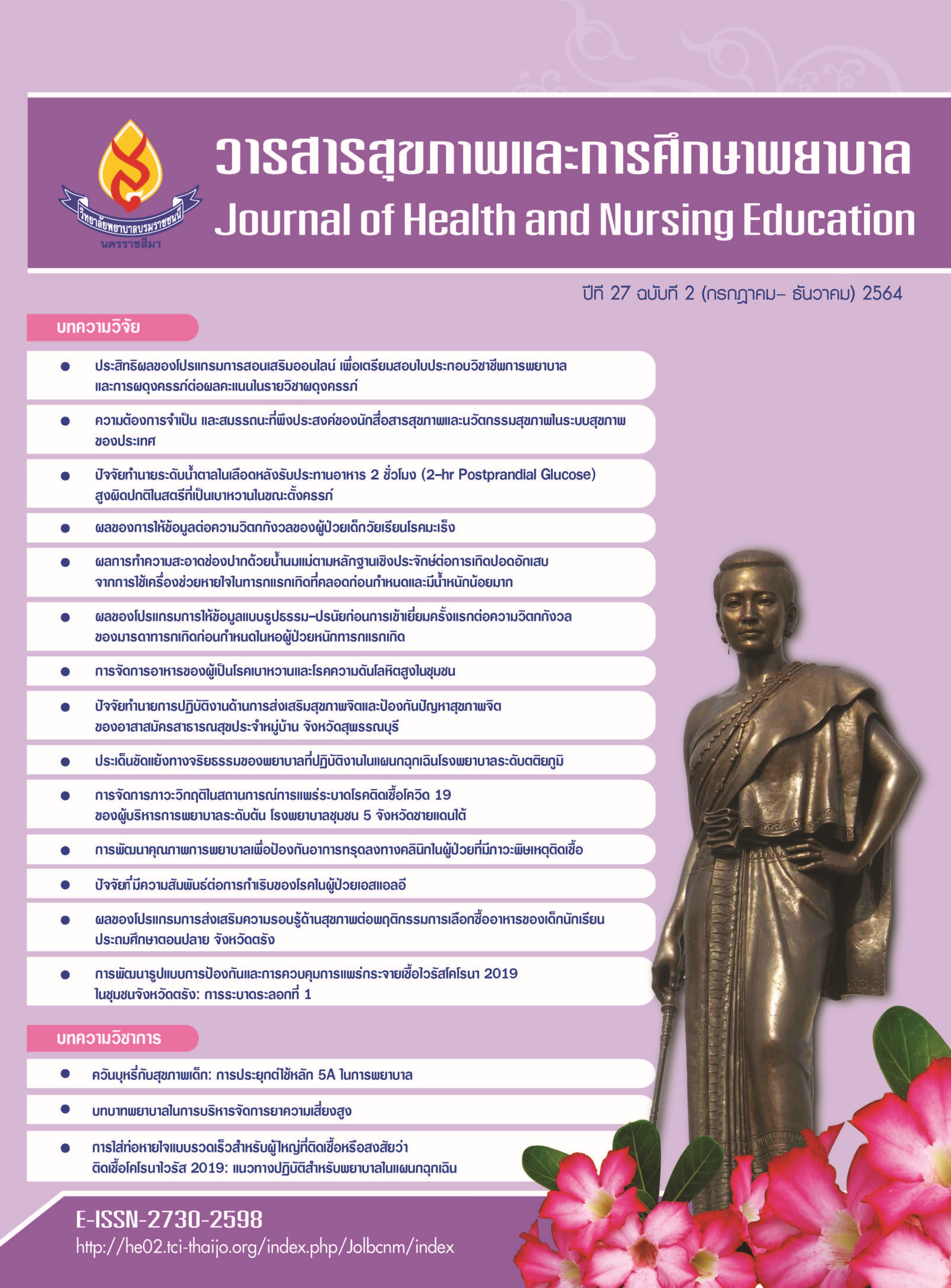การใส่ท่อหายใจแบบรวดเร็วสำหรับผู้ใหญ่ที่ติดเชื้อหรือสงสัยว่าติดเชื้อ โคโรนาไวรัส 2019: แนวทางปฏิบัติสำหรับพยาบาลในแผนกฉุกเฉิน
คำสำคัญ:
การใส่ท่อหายใจแบบรวดเร็ว, การแพร่ระบาดของเชื้อไวรัสโคโรนา 2019, พยาบาลในแผนกฉุกเฉินบทคัดย่อ
การใส่ท่อหายใจแบบรวดเร็ว หมายถึง การใช้ยานำสลบร่วมกับยาหย่อนกล้ามเนื้อในขณะใส่ท่อหายใจ เพื่อเพิ่มประสิทธิภาพของการทำหัตถการ ซึ่งช่วยลดระยะเวลาของการทำหัตถการ ภาวะแทรกซ้อน และความเสี่ยงในการแพร่กระจายของโรคไปกับละอองฝอยระหว่างการใส่ท่อหายใจ ดังนั้นในช่วงการแพร่ระบาดของเชื้อไวรัสโคโรนา 2019 การใส่ท่อหายใจแบบรวดเร็ว และการสวมชุดป้องกันไวรัสจึงถูกดัดแปลงมาใช้ในแผนกฉุกเฉิน เพื่อลดการแพร่กระจายของไวรัสจากละอองฝอยในขณะใส่ท่อหายใจ การทำหัตถการนี้จึงเป็นความท้าทายสำหรับพยาบาลที่ปฏิบัติงานในแผนกฉุกเฉิน เพราะจะต้องช่วยทำหัตถการให้เกิดความปลอดภัยต่อผู้ป่วยและเกิดประสิทธิภาพสูงสุดแม้ว่าจะอยู่ในภาวะเร่งด่วน พยาบาลเวชปฏิบัติในแผนกฉุกเฉินจะต้องปฏิบัติการด้วยความเชี่ยวชาญ ด้วยการประเมินและเตรียมผู้ป่วย ช่วยแพทย์ขณะใส่ท่อหายใจ และเฝ้าระวังและป้องกันภาวะแทรกซ้อนหลังการทำหัตถการ บทความนี้อธิบายขั้นตอนที่สำคัญของการใส่ท่อหายใจแบบรวดเร็ว และแนวทางสำหรับพยาบาลตลอดกระบวนการใส่ท่อหายใจแบบรวดเร็วในแผนกฉุกเฉิน
เอกสารอ้างอิง
กรมควบคุมโรค. (2564). โรคติดเชื้อไวรัสโคโรนา 2019. สืบค้นจาก https://ddc.moph.go.th/viralpneumonia/index.php
Armstrong, B., Reid, C., Heath, P., Simpson, H., Kitching, J., Nicholas, J., . . . Rush, H. (2009). Rapid sequence induction anaesthesia: A guide for nurses in the emergency department. International emergency nursing, 17(3), 161-168.
Avery, P., Morton, S., Raitt, J., Lossius, H. M., & Lockey, D. (2021). Rapid sequence induction: Where did the consensus go?. Scandinavian Journal of Trauma, Resuscitation and Emergency Medicine, 29(1), 1-9.
Bilhimer, M. H., Groth, M. E., & Holmes, A. K. (2020). Ketamine for migraine in the emergency department. Advanced Emergency Nursing Journal, 42(2), 96-102.
Botha, J. C., Lourens, A., & Stassen, W. (2021). Rapid sequence intubation: A survey of current practice in the South African pre-hospital setting. International Journal of Emergency Medicine, 14(45). https://doi.org/10.1186/s12245-021-00368-3
Breindahl, N., Baekgaard, J., Christensen, R. E., Jensen, A. H., Creutzburg, A., Steinmetz, J., & Rasmussen, L. S. (2021). Ketamine versus propofol for rapid sequence induction in trauma patients: A retrospective study. Scandinavian Journal of Trauma, Resuscitation and Emergency Medicine, 29(1), 1-8.
Brown III, C. A., & Walls, R. M. (2018). Rapid sequence intubation. The Walls Manual of Emergency Airway Management, 5, 235.
Cabrini, L., Landoni, G., Redaelli, M. B., Saleh, O., Votta, C. D., Fominskiy, E., . . . Zangrillo, A. (2018). Tracheal intubation in critically ill patients: A comprehensive systematic review of randomized trials. Critical Care, 22(1), 1-9.
Caputo, N. D., Oliver, M., West, J. R., Hackett, R., & Sakles, J. C. (2019). Use of end tidal oxygen monitoring to assess preoxygenation during rapid sequence intubation in the emergency department. Annals of Emergency Medicine, 74(3), 410-415.
Driver, B. E., Klein, L. R., Prekker, M. E., Cole, J. B., Satpathy, R., Kartha, G., . . . Reardon, R. F. (2019). Drug order in rapid sequence intubation. Academic Emergency Medicine, 26(9), 1014-1021.
Groombridge, C. J., Maini, A., Olaussen, A., Kim, Y., Fitzgerald, M., & Smit, D. V. (2021). Unintended consequences: The impact of airway management modifications introduced in response to COVID‐19 on intubations in a tertiary centre emergency department. Emergency Medicine Australasia, 33, 728-733.
Kriswidyatomo, P., & Paramitha, M. P. (2021). Rapid sequence induction/intubation controversies. Hong Kong Journal of Emergency Medicine, 28(5) 314–319.
Nimmagadda, U., Salem, M. R., & Crystal, G. J. (2017). Preoxygenation: Physiologic basis, benefits, and potential risks. Anesthesia & Analgesia, 124(2), 507-517.
Perera, A., Alkouri, H., Fogg, T., Vassiliadis, J., Mackenzie, J., & Wimalasena, Y. (2021). Apnoeic oxygenation was associated with decreased desaturation rates during rapid sequence intubation in multiple Australian and New Zealand emergency departments. Emergency Medicine Journal, 38(2), 118-124.
Shavit, I., Levit, B., Basat, N. B., Lait, D., Somri, M., & Gaitini, L. (2015). Establishing a definitive airway in the trauma patient by novice intubators: A randomised crossover simulation study. Injury, 46(11), 2108-2112.
Tintinalli, J. E., John Ma, O., Yealy, D. M., Meckler, G. D., Stapczynski, J. S., Cline, D. V., & Thomas, S. (2020). Tintinalli’s emergency medicine: A comprehensive study guide (9th ed.). New York: McGraw-Hill.
Tran, D. T. T., Newton, E. K., Mount, V. A. H., Lee, J. S., Mansour, C., Wells, G. A., & Perry, J. J. (2017). Rocuronium vs. succinylcholine for rapid sequence intubation: A Cochrane systematic review. Anaesthesia, 72(6), 765-777.
Walls, R. M., Hockberger, R. S., & Gausche-Hill, M. (2018). Rosen’s emergency medicine: Concepts and clinical practice (9th ed.). Philadelphia: Elsevier.
Wilson, J. W., Gillen, J. P., & Maute, T. (2020). Patient safety during rapid sequence intubation when using succinylcholine instead of nondepolarizing paralytic agents: Should we change a common rapid sequence intubation pathway? Journal of Emergencies Trauma and Shock, 13(4), 264-268.
World Health Organization. (2021). Global research on coronavirus disease. Retrieved from https://www.who.int/emergencies/diseases/novel-coronavirus-2019/global-research-on-novel-coronavirus-2019-ncov
ดาวน์โหลด
เผยแพร่แล้ว
ฉบับ
ประเภทบทความ
สัญญาอนุญาต
ลิขสิทธิ์ (c) 2021 วารสารสุขภาพและการศึกษาพยาบาล

อนุญาตภายใต้เงื่อนไข Creative Commons Attribution-NonCommercial-NoDerivatives 4.0 International License.
บทความที่ได้รับการตีพิมพ์เป็นลิขสิทธิ์ของ วารสารสุขภาพและการศึกษาพยาบาล ซึ่งดำเนินการโดยวิทยาลัยพยาบาลบรมราชชนนี นครราชสีมา
ข้อความที่ปรากฏในบทความในวารสารเล่มนี้เป็นความคิดเห็นส่วนตัวของผู้เขียนแต่ละท่านไม่เกี่ยวข้องกับกองบรรณาธิการวารสารสุขภาพและการศึกษาพยาบาล หรือวิทยาลัยพยาบาลบรมราชชนนี นครราชสีมา แต่อย่างใด ความรับผิดชอบองค์ประกอบทั้งหมดของบทความแต่ละเรื่องเป็นของผู้เขียนแต่ละท่าน หากมีความผิดพลาดใดๆ ผู้เขียนแต่ละท่านจะรับผิดชอบบทความของตนเองแต่ผู้เดียว







